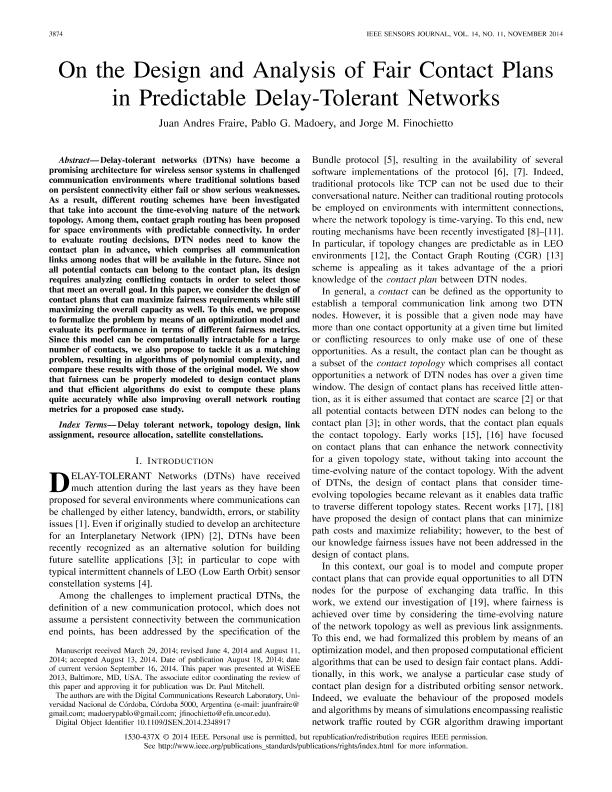Mostrar el registro sencillo del ítem
dc.contributor.author
Fraire, Juan Andres

dc.contributor.author
Madoery, Pablo Gustavo

dc.contributor.author
Finochietto, Jorge Manuel

dc.date.available
2018-01-25T20:45:13Z
dc.date.issued
2014-11
dc.identifier.citation
Fraire, Juan Andres; Madoery, Pablo Gustavo; Finochietto, Jorge Manuel; On the Design and Analysis of Fair Contact Plans in Predictable Delay-Tolerant Networks; Institute of Electrical and Electronics Engineers; IEEE Sensors Journal; 14; 11; 11-2014; 3874-3882
dc.identifier.issn
1530-437X
dc.identifier.uri
http://hdl.handle.net/11336/34648
dc.description.abstract
Delay-tolerant networks (DTNs) have become a promising architecture for wireless sensor systems in challenged communication environments where traditional solutions based on persistent connectivity either fail or show serious weaknesses. As a result, different routing schemes have been investigated that take into account the time-evolving nature of the network topology. Among them, contact graph routing has been proposed for space environments with predictable connectivity. In order to evaluate routing decisions, DTN nodes need to know the contact plan in advance, which comprises all communication links among nodes that will be available in the future. Since not all potential contacts can belong to the contact plan, its design requires analyzing conflicting contacts in order to select those that meet an overall goal. In this paper, we consider the design of contact plans that can maximize fairness requirements while still maximizing the overall capacity as well. To this end, we propose to formalize the problem by means of an optimization model and evaluate its performance in terms of different fairness metrics. Since this model can be computationally intractable for a large number of contacts, we also propose to tackle it as a matching problem, resulting in algorithms of polynomial complexity, and compare these results with those of the original model. We show that fairness can be properly modeled to design contact plans and that efficient algorithms do exist to compute these plans quite accurately while also improving overall network routing metrics for a proposed case study.
dc.format
application/pdf
dc.language.iso
eng
dc.publisher
Institute of Electrical and Electronics Engineers

dc.rights
info:eu-repo/semantics/openAccess
dc.rights.uri
https://creativecommons.org/licenses/by-nc-sa/2.5/ar/
dc.subject
Delay Tolerant Network
dc.subject
Topology Design
dc.subject
Link Assignment
dc.subject
Resource Allocation
dc.subject.classification
Ingeniería de Sistemas y Comunicaciones

dc.subject.classification
Ingeniería Eléctrica, Ingeniería Electrónica e Ingeniería de la Información

dc.subject.classification
INGENIERÍAS Y TECNOLOGÍAS

dc.title
On the Design and Analysis of Fair Contact Plans in Predictable Delay-Tolerant Networks
dc.type
info:eu-repo/semantics/article
dc.type
info:ar-repo/semantics/artículo
dc.type
info:eu-repo/semantics/publishedVersion
dc.date.updated
2018-01-24T14:45:30Z
dc.journal.volume
14
dc.journal.number
11
dc.journal.pagination
3874-3882
dc.journal.pais
Estados Unidos

dc.description.fil
Fil: Fraire, Juan Andres. Universidad Nacional de Córdoba. Facultad de Ciencias Exactas, Físicas y Naturales; Argentina. Consejo Nacional de Investigaciones Científicas y Técnicas; Argentina
dc.description.fil
Fil: Madoery, Pablo Gustavo. Universidad Nacional de Córdoba. Facultad de Ciencias Exactas, Físicas y Naturales; Argentina. Consejo Nacional de Investigaciones Científicas y Técnicas; Argentina
dc.description.fil
Fil: Finochietto, Jorge Manuel. Universidad Nacional de Córdoba. Facultad de Ciencias Exactas, Físicas y Naturales; Argentina. Consejo Nacional de Investigaciones Científicas y Técnicas; Argentina
dc.journal.title
IEEE Sensors Journal

dc.relation.alternativeid
info:eu-repo/semantics/altIdentifier/doi/http://dx.doi.org/10.1109/JSEN.2014.2348917
dc.relation.alternativeid
info:eu-repo/semantics/altIdentifier/url/http://ieeexplore.ieee.org/document/6879454/
Archivos asociados
